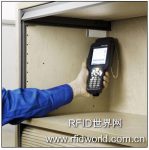
Finnish furniture manufacturer uses RFID technology to reform the way companies operate
[ad_1]
Finnish furniture manufacturer Martela is well-known for its innovative and modern designs. Now, the company uses RFID technology to reform the way the company operates.
Martela was founded in the 1950s and the company has greatly expanded its business scale in the past 10 years, said Johanna Kemppainen, the company’s marketing manager. Martela not only sells desks, chairs and furniture products to offices, schools, hotels and other users, but also provides management services for the entire life cycle of the products.
“Customers want more comprehensive services,” Kemppainen explained. After receiving the order, Martela delivers the goods to the customer and installs the furniture on the customer’s premises-but the partnership does not end there. As an additional service, the company will visit customers regularly and take inventory of customer furniture. On the one hand, this may be in order to meet the requirements of government audit regulations. On the other hand, it also helps the company to achieve internal asset tracking management. During the useful life of a piece of furniture, if it is damaged or out of style, Martela will ship a new piece of furniture to replace it.

<1> Martela workers use a handheld computer to write ID codes on the EPC Gen 2 passive tags on the furniture
Although this service provides Martela with an important competitive advantage in the market, Kemppainen said, it also brings a heavy burden on labor costs for the company. “We realize that inventory counting is a big task for us,” she said. The company’s employees use a purely manual method to inventory the furniture at the customer’s premises-not even using bar codes. In this way, when the management decided to automate the process, RFID technology was directly selected.
So far, Martela has implemented RFID tracking systems for three customers. When workers receive an order and are ready to ship, they will stick a Confidex passive EPC Gen 2 RFID tag on each product in an inconspicuous spot, and use the tag to quickly locate each piece of furniture to achieve inventory counting. In the past, the average inventory time for furniture in each office was 10 minutes, and RFID applications reduced it to 10 seconds. According to Ville Lukkari, business manager of RFID system integrator Vilant, Vilant developed this solution for Martela.
Martela employees use NordicID PL3000 UHF handheld RFID readers to write a unique identification code to each tag. This number corresponds to the model number of the furniture and other attributes, such as color and customer order information. In addition, an independent label is installed on the door frame of each room to mark the location of each piece of furniture. Workers have to read the room tag at the beginning of each inventory.

<2>A separate label is also installed on the door frame of each room
In early testing, Vilant tried to use the NordicID Cross Dipole handheld to write the unique ID code of the tag. However, the company found that the reading distance of this reader was too long-up to 4 meters, which made it difficult to guarantee the correct ID. The code is written to the correct label (due to the close distance between the labels). To correct this problem, Vilant chose a PL3000 UHF reader with a shorter reading distance (up to 1.6 meters). When counting, Martela employees use Cross Dipole handheld readers, taking into account that its longer reading distance can help employees more effectively collect tag ID codes.
When the worker walks into the room and counts the furniture, the Cross Dipole reader will make a beep every time the tag is read. The ID code of the tag will also be displayed on the screen of the device. The Vilant software can remove repeated reading. The reader will only sound when the same tag is read for the first time. If it is read repeatedly in the future, the reader will not sound again. .
When the employee completes the inventory count in the designated area, he holds the opportunity to display which pieces of furniture are new and which have been removed from the old inventory, or whether the item list is still consistent. Every time a room inventory is completed, Vilant’s RFID software will upgrade Martela’s inventory. Martela shares inventory information with customers.
Kemppainen stated that Martela plans to promote the system to all customers. “Customers are very happy to get tag data,” she said, “because tag data helps companies quickly identify and track each piece of furniture, which improves customer asset management and utilization.”
[ad_2]



